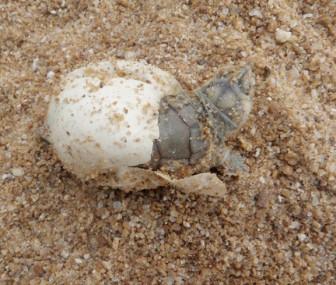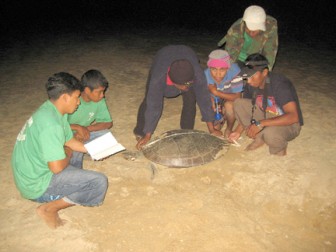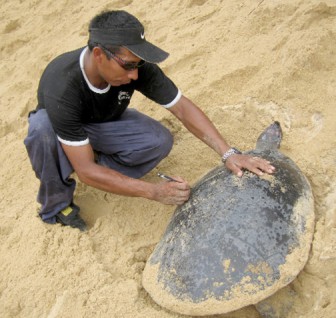

Giant River Turtles (Podocnemis expansa) are found in the Guianas, Venezuela and the Amazon as well as in rivers, lakes and ponds in the Iwokrama Forest and the Rupununi. Females and males look similar and their large flattened carapace (shell) can measure up to a metre in length.

These dark grey turtles can sometimes be seen in remote, quiet and undisturbed ponds, poking their noses to the surface to breathe. As river levels drop, females migrate up rivers, climbing up rocks and rapids to reach the place where they once hatched.
This arduous journey is made in order to nest, and during the nights of the dry season, females emerge onto sand beaches to lay their eggs; a typical nest is about 2-3 feet deep and contains approximately 80-200 round, leathery soft eggs. One month later, the hatchlings dig their way from their sand nest and scuttle to the water’s edge for safety.

Like marine turtles, Giant River Turtles are threatened by hunting, the gathering of their eggs and habitat destruction; humans, lizards, birds and animals dig and eat the eggs, fish and birds prey on hatchlings, but only humans and jaguars prey on full-grown adults. Traditionally, river turtles are an important food resource for Amerindians, and their plastron (belly shell) is used to make spindles for spinning cotton.

Turtles are reptiles and have a slow growth and reproduction rate and as local populations increase and access to hinterland areas opens, overharvesting of adults and eggs has become a threat to the population. Since 2008, Iwokrama and community members of North Rupununi District Development Board (NRDDB) have been monitoring the river turtles in the Rupununi area and hope to be able to monitor and sustainably manage this important animal.
Rain forests are rich in biodiversity and are home to many different plants and animals as well as for indigenous communities. Even if you don’t live in the rain forest, humans rely on the forest for resources such as building materials (wood and lianas), medicine and fruits. Rain forest produce also provides essential environmental services for life on earth; they create soil as well as prevent soil erosion, produce oxygen though photosynthesis, maintain clean water systems, and are a key defence against climate change.
The Iwokrama Rain Forest is 371,000 hectares, located in the heart of Guyana. Our mission is to develop strategies for conservation and sustainable development for local people in Guyana and the world at large. We are involved in tourism, training, research and our timber is certified by the Forest Stewardship Council. Come and visit us in the rain forest or at http://www.iwokrama.org.









